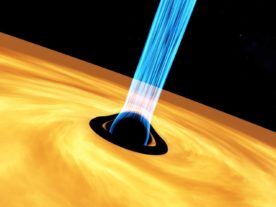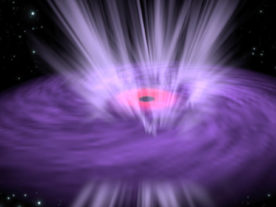
Scientists: It’s New Era In Space Research
Members of the science community are proclaiming a new era in space research after discovering the first verified source of a super-energetic subatomic particle called a high-energy neutrino. Researchers from the Pennsylvania State University say that these neutrinos contain energies that are thousands to millions of times greater than those generated by particle colliders/accelerators such […]

NASA Prevents Space Wreck; Black Hole Winds; Oldest Fossils Found
NASA Prevents a Wreck at Mars The folks at NASA’s MAVEN program recently had to give their spacecraft a small unscheduled course correction so that it wouldn’t smash into Mars’s moon Phobos. The spacecraft that’s been circling the Red Planet for a little over two years conducted a motor burn that give it a slight […]
NASA’s NuStar Mission Finds Rare Pulsar that Pumps Out the Energy of 10 Million Suns
This animation shows a neutron star—the core of a star that exploded in a massive supernova. This particular neutron star is known as a pulsar because it sends out rotating beams of X-rays that sweep past Earth like lighthouse beacons. (NASA/JPL-Caltech) NASA’s Nuclear Spectroscopic Telescope Array (NuSTAR) mission recently made a remarkable discovery that could […]
Volunteers, Home Computers Help Identify Gamma Ray Pulsars
A network of 40,000 volunteer researchers, along with 200,000 personal computers worldwide, has helped scientists from the Max Planck Institutes for Gravitational Physics and Radio Astronomy – the Albert Einstein Institute (AEI) discover four gamma-ray pulsars. Pulsars are compact and rapidly rotating neutron stars which are the remains of stars that have exploded. The discoveries […]
